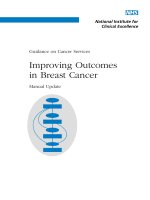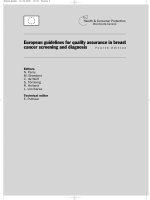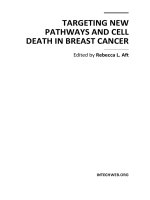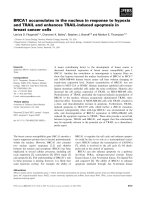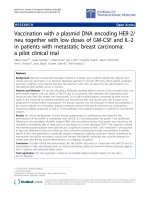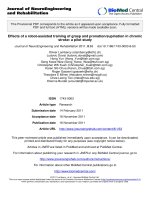In vivo and in vitro study on potential combination therapy of COL 3 and tamoxifen in breast cancer a pilot study
Bạn đang xem bản rút gọn của tài liệu. Xem và tải ngay bản đầy đủ của tài liệu tại đây (1.7 MB, 134 trang )
Chapter 1 Introduction
1.1 BACKGROUND
1.1.1
Overview of Current Breast Cancer Therapy
The current treatment of breast cancer is a multidisciplinary effort, with goals
dependent on the specific clinical situation. Various clinical breast cancer treatment
are listed in Table 1.1 [1-4].
For patients who have not actually developed breast cancer but at high risk for the
development of the disease, prevention of the breast cancer with a selective estrogen
receptor modulator (tamoxifen) is more frequently used to treat established disease[5,
6].
Patients with non-invasive disease (intraductal carcinoma or ductal carcinoma in situ)
are now routinely treated with surgery (mastectomy in some cases, breast
conservation with or without radiation therapy in others) followed by a treatment with
tamoxifen[7-9].
Patients with invasive breast cancer are generally treated with surgery followed by
adjuvant systemic therapy tailored to their level of risk. At the same time, it is
common to see patients treat with preoperative (‘neo-adjuvant’) therapy. For them,
interpretation of operative findings can be a challenge[10-12].
1
Patients with hormone receptor-positive early-stage tumors---almost without regard to
tumor size or other risk factors—are routinely offered adjuvant hormonal treatment.
Tamoxifen remains a gold standard for patients of all ages, but there is increasing
evidence regarding the role that aromatase inhibitors may play in postmenopausal
patients[13]. At present, we know that an average planned course of 5 years of
tamoxifen is probably appropriate for most patients. Longer or shorter durations might
be optimal for selected patients, there is even more reason to carefully evaluate the
risks and benefits of ovarian ablation as a component of systemic treatment[14-16].
It is apparent that treatment of breast cancer is evolving rapidly and has changed
dramatically over the past decade. Given the understanding of the basic biology of
breast cancer, the pending revolution in our ability to finely subtype it, and the
availability of hundreds of novel agents, it seems reasonable to expect the
improvements of the past decades to accelerate in the future[17].
Table 1.1 Summary of breast cancer treatment
Therapy
Agent used
Surgery
purpose
remove as much of tumor as possible[1]
Doxorubicin
Cyclophosphamide
Chemotherapy
methotrexate
use of anti-cancer drugs that go throughout the entire body
Fluorouracil
to prevent recurrence[2-4]
Carmustine (BCNU)
6-mercaptopuri
Vincristin
Radiotherapy
reduce the risk of local recurrence;
kill tumor cells that may be living in lymph nodes[2-4]
Hormonal therapy
Tamoxifen
reduce the risk of recurrence
Aromatas inhibitors (Letrozole) if tumor expresses estrogen receptors[2-4]
Biologic therapy
Herceptin (or Trastuzumab)
block receptor HER-2/neu[3]
2
1.1.2
The Role of Angiogenesis in Breast Cancer
Angiogenesis, the process of new blood vessel formation, plays a crucial role in local
tumor growth and distant metastasis in breast cancer[18]. Angiogenesis precedes
transformation of mammary hyperplasia to malignancy. Transfection of tumor cells
with angiogenic stimulatory peptides increases tumor growth, invasiveness, and
metastasis. Conversely, inhibitors of angiogenesis will decrease growth and
metastasis of tumor cells[19].
Tamoxifen, initially believed to be a competitive inhibitor of estradiol, may have
estrogen-independent mechanisms of action[20]. It has been reported that tamoxifen
has antiangiogenic activity (Table 1.2).
Other agents used in breast cancer, which have antiangiogenic activity, include
several
chemotherapeutic
agents
(paclitaxel[21],
cyclophosphamide[22],
methotrexate[23], etc.), protease inhibitors[24], growth factor/receptor antagonists[25]
and endothelial toxins[26].
Table 1.2 Antiangiogenic activity of tamoxifen
Reference
Antiangiogenic activity of tamoxifen
Inhibits VEGF (vascular endothelial growth factor) and fibroblast
[27, 28]
growth factor (FGF)-simulated embryonic angiogenesis
Decrease endothelial density and increases the extent of necrosis
[29]
in MCF-7 tumors growing in nude mice
Inhibition of angiogenesis was detected before measurable effects
[30]
on tumor volume
Down-regulation of CD36, a glycoprotein recptor for matrix
[31]
proteins, thrombospondin-1, and collagen types I and IV
3
1.1.3
Overview of Combination Therapy in Cancer Treatment
Sometimes, more than one type of treatment is used to treat breast cancer.
Combination therapy may be adjuvant therapy - two types of treatment such as
surgery followed by radiation or concurrent therapy - two types of treatment given
during the same period of time. With surgery becoming more conservative in the
amount of tissue that is removed, it is common for even those with early stage cancers
to receive combination therapy. Examples for combination therapy in breast cancer
treatment are shown in Table 1.3.
Early in the 1950’s, some encouraging results already showed that combined drug
therapy improved the treatment of cancer, even though most patients treated had
advanced solid tumors[32, 33]. In the past few decades, concept of “synergism” has
been developed, that in the combination therapy, chemotherapeutic agents interfere
with either differing metabolic pathways or act at different sites in the same pathway.
This concept of synergism suggested that drugs might be used together to block the
formation of essential cellular components, resulting in tumor cell death[34]. Several
mechanistic concepts evolved, including sequential blockade, or the inhibition of two
or more enzyme-mediated steps in the production of a necessary metabolite;
concurrent blockade, or the inhibition of two or more parallel pathways in the
synthesis of the necessary metabolite; and complementary inhibition, or the
interference with different but related biochemical processes[35-37].
4
Table 1.3 Combination Regimens in breast cancer treatment [38]
Abbreviation
ACe
Regimen
2
Doxorubicin 45 mg/m IV day1
Frequency
Every 3 to 4 weeks
2
Cyclophosphamide 200 mg/m /d PO days 3-6
CAF
Cyclophosphamide 100 mg/m2 /d PO days 1-14
Doxorubicin 30 mg/m2/d IV day1,8
2
Fluorouracil 500 mg/m /d IV days 1,8
Every 4 weeks until 450mg/m2
of doxorubicin then start methotrexate 40 mg/m2 IV and increase
5-FU to 600mg/m2 IV
CMF
Cyclophosphamide 100 mg/m2 /d PO days 1-14
Every 4 weeks
2
Methotrexate 40-60 mg/m /d IV days 1,8
Fluorouracil 600 mg/m2/d IV days 1,8
CMFP
Cyclophosphamide 100 mg/m2 /d PO days 1-14
Every 4 weeks
2
Methotrexate 60 mg/m /d IV days 1,8
Fluorouracil 700 mg/m2/d IV days 1,8
Prednisone 400 mg/m2/d PO days 1-14
CMFVP
Cyclophosphamide 2.5mg/kg PO daily
Methotrexate 25-50 mg IV weekly
Every week for 8 weeks followed
by reduced therapy for maintenance
Fluorouracil 12 mg/kg/d IV days 1-4, then 500mg
IV weekly
Vincristine 0.035 mg/kg IV weekly
(max dose 2 mg)
Prednisone 0.75 mg/kg PO daily
FAC
Fluorouracil 500 mg/m2/d IV days 1,8
Every 3 weeks
2
Doxorubicin 50 mg/m /d IV day1
Cyclophosphamide 500 mg/m2 IV days 1
MV1b
Mitomycin 15-20 mg/m2 IV day 1
Every 6-8 weeks
2
Vinblastine 6 mg/m IV/d days 1,21
5
1.2 TAMOXIFEN
Ph
Z
Me 2 N
Et
Ph
O
Figure 1.1 Chemical structure of tamoxifen
1.2.1 Chemistry
Chemically, tamoxifen is the trans-isomer of a triphenylethylene derivative (Figure
1.1).
The
chemical
name
is
(Z)2-[4-(1,2-diphenyl-1-butenyl)phenoxy]-N,N-
dimethylethanamine 2-hydroxy-1,2,3- propanetricarboxylate (1:1).
Tamoxifen citrate has a molecular weight of 563.62, the pKa' is 8.85, the equilibrium
solubility in water at 37°C is 0.5 mg/ml and in 0.02 N HCl at 37°C, it is 0.2 mg/ml.
1.2.2
Pharmacology
Tamoxifen is one of the Selective estrogen receptor modulators (SERMs), which are a
class of compounds with interesting pharmacology[39]. They have the capability of
acting as estrogen receptor (ER) agonists in some tissues and as antagonists in
others[40-43]. Tamoxifen is a potent ER antagonist, and its major antitumour activity
is achieved by competitively inhibiting estradiol binding at the estrogen receptor[40,
44]. Therefore, patients with ER positive cancers respond best to tamoxifen treatment
[45].
6
1.2.3
Clinical Use
Tamoxifen (Nolvadex) has been the standard hormonal agent used for breast cancer.
It is the prototype for a growing class of compounds called selective estrogen
receptor- modulators (SERMs). SERMs chemically resemble estrogen and trick the
breast cancer cells into accepting it in place of estrogen. Unlike estrogen, however,
they do not stimulate breast cancer cell growth. Other SERMs being studied for breast
cancer include toremifene (which is very similar to tamoxifen), idoxifene, and
droloxifene[39].
The antiestrogenic effects of tamoxifen are manifest over a wide range of dose. A
dose of 10 to 20 mg, twice daily, was used in early clinical trials. The dose-response
effect of tamoxifen was tested over a range of 2 to 100 mg/m2 body surface area,
twice daily. No clear increase in antitumor activity of tamoxifen was shown with the
larger doses[46].
Tolerance to tamoxifen is good. The most frequent side effect has been hot flushes,
which are tolerable in most patients. Approximately 10% patients have mild nausea
and vomiting that can be quite severe and require interrupting treatment. A less
frequent side effect is bone pain[47]. Other rare side effects include vaginal bleeding,
thrombophlebitis, and ocular toxicity[48-50].
Tamoxifen can be used in the treatment of metastatic breast cancer in postmenopausal
women (Table 1.4) as well as in premenopausal women (adjuvant trials) (Table 1.5).
7
Tamoxifen as adjuvant treatment in postmenopausal has been established as useful,
either alone or combined with chemotherapy.
Table1.4 Tamoxifen in Premenopausal Patients (Phase II studies)
Reference
Tamoxifen Dose
Patients (n)
Remarks
[51]
20 mg twice daily
10
First trial to show antitumor activity
[52]
20 mg twice daily
11
Response observed despite incomplete
suppression of ovarian function
[53],[54]
20 mg twice daily
74
Median duration of response, 13 months
[55]
10 mg twice daily
21
Response duration, 3 to 18 months
[56]
10 to 20 mg twice daily
26
No evidence of dose-response relationship
[57]
10 mg twice daily
38
Median duration of response, 9 months
[58]
10 mg twice daily
44
Response duration, 3 months
[59]
20 mg twice daily
43
Median response duration, 20 months
Table 1.5 Adjuvant Trials with Tamoxifen in Postmenopausal Patients
Reference
Patients
[60]
588
Dose of Tamoxifen
Remarks
20 mg/day
Trend toward increase in survival
but not significant
[61]
656
40 mg/day
No difference in survival
[62]
1135
10 mg twice daily
Significant increase in survival of
patients treated with tamoxifen
[63]
503
20 mg/day
Survial similar; estrogen receptors
unknown in 52% of patients
[64]
1650
10 mg twice daily
Trend toward improved survival
with tamoxifen; estrogen receptors
unknown in 80% patients
[65]
170
10 mg twice daily
Survial unchanged; estrogen receptors
[66]
400
10 mg twice daily
Survival unchanged except for a trend
positive in 85 %
in progesterone-receptor-positive
tumors
[67]
1312
20 mg/day
Significant increase in survival of
all patients
[68]
179
40 mg/day
Significant improvement in 5-year
survival of patients with receptorpositive tumors
8
1.2.4
Pharmacokinetics
1.2.4.1 Human Study
Absorption. Tamoxifen is rapidly absorbed from the gastrointestinal tract[69]. Its
bioavailability is high (approximately 100%) and independent of dose, suggesting
minimal first-pass metabolism[70, 71]. Following single-dose administration of
tamoxifen 40 mg, peak plasma concentration (Cmax) was approximately 65 μg/L and
time to Cmax (tmax) was reached in 3-4 hours in healthy subjects[72]. Cmax was dose
dependent[73].
Distribution. Tamoxifen is highly lipophilic agents, resulting in extensive plasma
protein binding (>95%), with the majority bound to albumin[44, 71, 74]. Complete
tissue distribution studies have been conducted in animals using [14C]tamoxifen. High
concentrations of radioactivity were found in the breast tissue, uterus, liver, kidney,
lung and pancreas[75]. A human study of tamoxifen distribution was conducted by
Lien et al[76] in 14 patients ranged in age from 28 to 89 years of age, and biopsies
were recovered during surgery or autopsy over the course of 3 years. High
concentrations of tamoxifen were found in liver, lung, pancreas, brain, ovaries and
breast tissue. Distribution of tamoxifen in the human uterus was studied by Fromason
and Sharp[77] in women prior to hysterectomy. Tamoxifen has a high affinity for the
endometrium, as tamoxifen concentrations were found to be 2-3 times higher in the
uterus than in plasma[77, 78]. In humans, the apparent volume of distribution was
approximately 50-60 L/kg[79].
9
Metabolism. Tamoxifen undergoes phase I metabolism in the liver by microsomal
cytochrome P450 (CYP) enzymes[80, 81]. Tamoxifen is mostly metabolized by
CYP3A and CYP2C isoforms[82], but CYP2D6 may also be involved. The major
metabolites of tamoxifen are N-desmethyltamoxifen (resulting from N-demethylation)
and 4-hydroxytamoxifen (resulting from 4-hydroxylation)[83-85].
Excretion. Tamoxifen is excreted in the bile and eliminated through the faces, with
small amounts eliminated in the urine[44, 78, 83]. Following oral administration of
tamoxifen, elimination is biphasic and is dependent on the cumulative dose. The
terminal elimination half-life (t1/2β) of tamoxifen is 5-7 days, which may be due to
enterohepatic
circulation,
plasma
protein
binding
and
autoinhibition
of
metabolism[44, 71, 81, 83, 86, 87].
Steady-state pharmacokinetics. Steady-state serum concentrations of tamoxifen are
usually achieved within 3-4 weeks of daily tamoxifen administration at dosage
ranging between 20 and 40 mg/day[44, 74, 83]. The average steady-state
concentrations for dosage of 20mg/day (long-term treatment) and 40 mg/day (2month treatment) ranged from 164-494 and 186-214 μg/L, respectively[74, 88, 89].
The area under the concentration-time curve (AUC) for tamoxifen following a
regimen of 10 mg tamoxifen twice daily for 21 days was 1597μg·h/L in women with
advanced breast cancer[90].
10
1.2.4.2 Animal Study
Distribution of tamoxifen and metabolites into tissues of rats:
In all rat tissues except fat, essentially the same amounts of drugs were found after 3
days and 14 days of treatment of tamoxifen, suggesting that steady-state is obtained
within 3 days. The content of tamoxifen and its metabolites in tissues was orders of
magnitude higher than in serum. The demethylated and hydroxylated metabolites
were abundant in most tissues, except in fat tissue, where tamoxifen was the
predomination species. The concentrations of the hydroxylated metabolite and the
demethylated metabolite were especially high in lung and liver and kidney.
In rat adipose tissue, the fluctuation in the tamoxifen and metabolite concentrations
during one dosing interval were less than those observed in other tissues of the rat.
Tamoxifen was the predominating species; only small amounts of the demethylated
metabolites and the hydroxylated metabolite were observed. These findings may be
explained by slow distribution of tamoxifen into fat tissue, where this lipophilic drug
partitions into lipid droplets and is preserved due to low activity of drug metabolizing
enzymes.
Tissue kinetics in rat and similar metabolite profiles in most tissues suggest an
exchange of tamoxifen and metabolites between most tissues, and between serum and
tissues, including brain. In contrast, fat tissue contains low levels of metabolites and
seems to sequester tamoxifen; it may function as a “deep” compartment[76].
11
Some studies also showed that rapid N-desmethylation and 4-hydroxylation of
tamoxifen resulting in similar serum levels of N-desmethyltamoxifen and 4hydroxytamoxifen to the parent compound in the mature mouse and, hence, similar
AUCs throughout a 96-hr study. In contrast, the immature rat has a less dominant 4hydroxylation pathway, but AUC for tamoxifen and N-desmethyltamoxifen was in a
similar ratio in the rat to that of the mouse. The rate of elimination from the serum
following a single large oral dose of tamoxifen is similar for tamoxifen, Ndesmethyltamoxifen, and 4-hydroxytamoxifen in the rat and the mouse[91].
1.3 COL-3
1.3.1 Chemistry
H
H
OH
R
S
S
NH 2
OH
OH
O
OH
O
O
Figure 1.2 Chemical structure of COL-3
COL-3, the simplest tetracycline, differs from tetracycline by the absence of the 4dimethylamino, 6-hydroxyl, and 6-methyl groups (Figure 1.2). COL-3 is the first nonantimicrobial, chemically modified tetracycline to be assessed for anticancer effects in
humans. Due to its physiochemical properties, it is anticipated that COL-3 would have
a longer half-life (t1/2) and larger volume of distribution (Vd) than tetracycline and
doxycyline[92]. COL-3 is a yellow, odorless crystalline compound with a molecular
12
weight of 371.35. Although the solubility of COL-3 increases with increasing pH, its
stability decreases with increasing pH. Due to the absence of the 4-dimethylamino
group, COL-3 cannot exist as a zwitterions and, therefore, differs from the
tetracyclines in its acid-base properties, which leads to its poor solubility (0.01mg/ml
in water at pH 4.3)[93]. It is readily soluble in organic solvents such as methanol,
polyethylene glycol, and benzyl alcohol.
1.3.2 Pharmacology
COL-3 is a non-antimicrobial chemically modified tetracycline (CMT). Since the first
CMT was described in 1987[94], more than 30 different CMTs, in which the 4dimethylamino group is removed., have been developed. CMTs lose the antibacterial
activity of tetracycline but retain or even enhance the inhibition activity of matrix
metalloproteinases (MMPs).
The MMPs are a family of ECM (extracellular matrix)-modifying enzymes associated
with the malignant phenotype, and studies with natural or synthetic MMP inhibitors
demonstrated that MMP activity is required for tumor progression and metastasis in
several model systems[95]. Inhibition of MMPs is obtained through protease
inhibitors such as α2-macroglobulin and by a group of specific tissue inhibitors of
metalloproteinases (TIMPs). It is thought that an imbalance between the activation
and inhibition of MMP activity in favor of the MMP activity plays an important role
in the pathophysiology of cancer by facilitating the invasion of tumor cells through
the ECM[96].
13
Unlike other MMPIs, tetracycline derivatives not only inhibit collagenase activity but
also downregulate its production, inhibit its activation, and increase the degradation of
the proenzyme[96]. COL-3 potentially inhibits MMPs (i.e., MMP-2, MMP-9, and
MT1-MMP) [97-100], which are believed to be positive contributors in tumor growth
and metastasis. With the development of second generation inhibitors with specificity
for individual MMP family member, one may be able to target specific events in
breast tumor progression associated with specific MMPs[95].
1.3.3 Clinical Use
Recently, CollaGenex Pharmaceuticals, Inc. carried out some studies, which showed
positive results of phase II clinical study evaluating effects of COL-3 for treating
rosacea presented at North Carolina Dermatology Association. The study achieved its
primary endpoint, demonstrating a greater reduction in inflammatory lesion count
from baseline for the COL-3 treated patients compared to the patients on placebo. At
endpoint (Day 42), COL-3 patients had a mean reduction of 12.8 lesions while
placebo patients showed an increase of 2.3 lesions. This difference was statistically
significant (p=0.0213). Importantly, the onset of action was very rapid, with
approximately 80% of the reduction in lesion count observed at Day 42 already
present at Day 14. At endpoint, 75% of all COL-3 treated patients were clear or nearclear of disease symptoms as measured by the Investigators Global Assessment score.
Erythema showed a slightly better improvement in the COL-3 group, with a 2.5-point
reduction in the clinician's erythema assessment score for the COL-3 group compared
to a 1.7-point reduction for the placebo group. COL-3 was well tolerated and the
adverse event profile was unremarkable.
14
Based on some promising preclinical studies, COL-3 has been evaluated in clinical
trials in patients with solid tumors who receive the agent by oral administration in a
continuous dosing schedule. 70 mg/m2/day administered orally and the dose limiting
toxicity was cutaneous photosensitivity, which was observed in 69% of patients.
Other side effect observed were generally mild, and included anemia, anorexia,
constipation, dizziness, elevated bilirubin and transaminases, fatigue, fever, headache,
hearburn, nausea, vomiting, neurotoxicities, and three cases of drug-induced lupus
erythematosus[101].
1.4 COMBINATION OF TAMOXIFEN WITH COL-3 AND DRUG-DRUG
INTERACTION
The combination of tamoxifen and COL-3 is rational, based on the marked antitumor
activity of both agents against a variety of solid tumors, such as breast cancer, prostate
cancer, lung cancer, colon cancer, etc, and their different mechanism. The difference
in the mechanism of action between the two drugs has led to this preclinical study
combining the two agents.
The inability to control metastasis is the leading cause of death in patients with
cancer. Control of metastasis, therefore, represents an important therapeutic
target[102]. Observations of some studies suggested that specific CMTs could
potentially be used to suppress the formation and magnitude of metastases associated
with certain cancers, and used in conjunction with other cancer treatment regimes,
lead to a more efficacious treatment of those metastatic diseases[100].
15
In several studies, MMP-2 has been shown to be expressed in breast carcinoma[103109]. In limited series, MMP-2 positivity is associated with unfavourable prognosis in
both premenopausal and postmenopausal node-positive breast carcinoma patient[110112]. Some studies also show that MMP-2 immunoreactive protein is an independent
prognostic indicator that might prove valuable in certain subgroups, such as patients
with a receptor-negative breast carcinoma. MMP-2 negativity was proved to serve as
a marker for distinctly favourable prognosis in breast carcinoma patients and MMP-2
positivity is also shown to correlate to poor survival in node-negative breast
carcinoma[113]. COL-3 is devoid of antimicrobial properties and is a competitive and
selective inhibitor of MMP-2 and MMP-9 isoenzymes, making it an attractive
candidate for clinical breast cancer treatment.
MMPIs should be regarded as cytostatic drugs that inhibit tumor growth. It is
theoretically attractive to combine MMPIs with some hormone therapy like using
tamoxifen to treat breast cancer so that their effectiveness can be augmented.
Tamoxifen is considered the golden standard for the hormonal therapy of breast
cancer in early stage. Several cased of drug-drug interaction have been reported about
tamoxifen (Table 1.6).
Medicines are often used concomitantly with other drugs, and some degree of drugdrug interaction occurs with concomitant use. Although only a small proportion of
this interaction is clinically significant, it sometimes causes serious adverse reactions.
For example, drug interactions, particularly with drugs having a narrow therapeutic
range, may have serious adverse consequences. Therefore, in the evaluation and
clinical application of drugs, appropriate efforts should be made to predict the nature
16
and degree of drug interactions so that patients will not be adversely affected. A
careful evaluation of the pharmacokinetic and pharmacodynamic profiles of drugs in
animal models is of primary importance for safety and effectiveness assessment prior
to clinical trails.
Several mechanisms may account for the drug-drug interaction. Pharmacokinetic
interaction, like drug-drug and nutrient-drug interaction at the absorption site is one of
the explanations to the mechanism of drug interaction[114]. The influence of wideranging factors such as the effect of fluid volume of gastrointestinal physiology,
splanchnic blood flow, passive diffusion, gastric emptying time, pH of the intestinal
contents, intestinal motility, ionic content of foods, dietary fat, and gastrointestinal
disease can have considerable effect on the absorption of drugs and they are
mechanisms common to both drug-drug and drug-food interactions in the gut.
Another mechanism of drug-drug interaction is the interactions at plasma- and tissuebinding sites. When a displacing agent interacts with a primary drug the result is an
increase in the free concentration of the displaced drug in the plasma. And the
increased free drug in the plasma quickly distributes throughout the body and may
localize in the tissue. Many interactions can also be explained by alterations in the
metabolic enzymes that are present in the liver and other extra-hepatic tissues.
Induction or inhibition of the collection of isoenzymes, such as cytochrome P450
enzymes,are mechanisms that have been shown to underlie some of the more serious
drug-drug interactions. Interactions involving renal excretory mechanisms can have
important clinical implications in terms of patient mortality and morbidity. Molecular
mechanism of renal drug transport has allowed predictions to be made of potential
drug interactions in early phase drug development[114].
17
Pharmacodynamic drug interaction, for instance, interaction at the receptor and other
active sites is one of the most common mechanisms by which pharmacodynamic
interactions occur. Not all drug-drug interactions are hazardous, and some synergistic
interactions when they occur can be of clinical value in therapy. Indeed some fooddrug interactions can be valuable especially when food improves the bioavailability of
the active drug substance. In other samples, the inhibition of the oxidative phase of
hepatic drug metabolism by, for example, cimetidine may potentiate the effect and/or
duration of a variety of drugs. Increasing the plasma concentration of a primary drug
may well also increase the probability of enhanced toxicity[115].
In current medical practice there are a number of examples of combined formulations
and/or co-prescribing of active ingredients on the basis of their believed synergistic
action. For many of these the evidence for efficacy may not stand up to critical
analysis.
Much of the drug interaction in vitro in the past has been interactions between drug
and drug, and drug and fluid in intravenous infusions. Newer work has concentrated
on interactions between specific drugs, notably chloroquine, cyclosporin insulin and
vasodilator nitrates, and pharmaceutical packaging materials (glass and plastics), and
the mechanisms by which these in vitro interactions occur[115].
Frequently the influence of medication on the reliability of subsequent laboratory tests
is not realized or merely overlooked. The mechanisms of such interactions can be
generally
classified
into
two
areas:
pharmacological
and
methodological
interferences. Whenever a drug-laboratory test interaction is established it should be
18
communicated to the medical community so that they may avoid possible errors in
diagnosis[115].
The present study was performed to investigate potential drug-drug interaction
between COL-3 and tamoxifen in female rats and further to examine the underlying
mechanism by some in vitro experiments.
Table 1.6 Reported interactions of tamoxifen
Effect
prothrombin time rose
plasma concentration of tamoxifen
Rifampicin (rifampin)
was reduced
Decreased serum concentrations of
Aminoglutethimide
tamoxifen and its metabolites
Decreased plasma concentrations
Letrozole
of letrozole
Interacting drug
Warfarin
References
[116]
[117]
[118]
[119],[120]
19
Chapter 2 Aims and Objectives
The novel anti-cancer agent COL-3 is one of the most potent CMTs (chemically
modified tetracyclines) studied to date and has demonstrated antitumor activity both
in vitro and in vivo[24]. Clinically, some of the patients with refractory metastatic
cancer showed some degree of clinical benefit from COL-3[121]. In a phase I study,
COL-3 was well tolerated and had moderate antitumor activity in patients with AIDSrelated Kaposi’s Sarcoma[122]. However, very limited data has been reported about
combination use of COL-3, except recently, it was found that acute doxorubicin
administration decreased COL-3 oral bioavailability and prolonged COL-3
elimination in rats[123]. In the present study, a potential combination therapy of
COL-3 and tamoxifen will be evaluated using some in vivo and in vitro models.
The main purpose of this research work is to assess the feasibility of coadministering
of tamoxifen, a nonsteroidal antiestrogen with inhibitory effect on estrogen-dependent
growth-stimulatory mRNA synthesis, and COL-3, an oral chemically modified
tetracycline derivative with potent inhibitory effect on matrix metalloproteinases
activity and production, against breast cancer using animal model and some in vitro
models.
The primary objective is to investigate the effect of tamoxifen on the pharmacokinetic
(PK) aspects of COL-3 in female rats. The PK profile of COL-3 would be examined
after its oral/intravenous administration given alone and with low-dose/high-dose
tamoxifen in fed/fasted female rats.
20
In addition, the effect of tamoxifen on in vitro serum protein binding of COL-3 would
be explored to investigate if protein displacement would be a source of the PK
interaction between COL-3 and tamoxifen in the animal study.
To evaluate whether these two drugs produce synergistic, additive, or antagonistic
effects on human cancer cell lines when given together, an in vitro investigation
would be conducted to examine the effects of COL-3 and tamoxifen, in single agent
or in combination against human breast cancer cell lines, MDA-MB-231 and MCF-7.
Finally, attempt would be made to account for an irregular absorption profile of COL3 with double- or plateau- peak concentration following oral administration of COL-3
in fed/fasted rats. Two-site absorption model[124], discontinuous absorption
model[125, 126] and two enterohepatic recirculation models[127] would be evaluated
to see which one is better with some meaningful PK parameters to describe COL-3
serum concentration-time profile after its oral administration with low/high dose
tamoxifen in fed/fasted rats.
21
Chapter 3 Analytical Methods
3.1 HIGH-PERFORMANCE LIQUID CHROMATOGRAPHIC METHOD FOR
THE DETERMINATION OF TAMOXIFEN IN BIOLOGICAL SAMPLES
3.1.1 Introduction
Tamoxifen is an anti-estrogenic agent widely used in the treatment of breast cancer
and many researchers have reported methods to determine tamoxifen and its
metabolites. Many of these methods involved conversion of tamoxifen and its
metabolites to their fluorescent phenanthrene derivatives followed by HPLC[128] or
TLC[129]. This reaction was carried out both pre- [128] and post- [130] column. Gas
liquid chromatography-mass spectrometry has also been used[131, 132].
There were also methods that using capillary electrophoresis[133].Also, methods that
involved solid-phase extraction had been reported. However, some of these methods
required tedious sample preparation procedure and some assays needs complicated
equipments such as photochemical reaction unit to convert tamoxifen to its
fluorescent derivative. Thus, a simple and sensitive method is desirable in our study
where a large number of serum samples need to be analyzed.
In the present study, a simple HPLC method with short retention time and good
separation was developed to analyze tamoxifen and its major metabolite, 4-OHtamoxifen, in rat serum.
22
3.1.2 Materials and Methods
Tamoxifen and its metabolite (4-OH-tamoxifen) were purchased from Sigma (St.
Louis, MO, USA). Methanol and acetonitrile, both were of high performance liquid
chromatography (HPLC) grade, were purchased from Tedia Company Inc (USA) and
Lab Scan (Thailand), respectively. Ammonium acetate was also purchased from
Sigma.
To determine the concentrations of tamoxifen and one of its major metabolites, 4-OHtamoxifen, in rat serum, 100μl of serum was deproteinized by adding 100μl
acetonitrile and allowed to stand at room temperature for 10 min. Then samples were
centrifuged at 10000g, 40C for 15 min. Supernatant was collected and an aliquot of
20μl was injected into the HPLC with UV detector. Shimadzu HPLC system (LC
2010A) (Shimadzu, Kyoto, Japan) was used. Chromatographic separation was
conducted on a XterraTM RP18 column (150 × 4.6 mm I.D., particle size 5μm) with
SentryTM guard column (XterraTM RP18, 20 × 3.9 mm I.D., particle size 5μm) (Waters,
Milford, MA, USA). The mobile phase consisted of 50mM ammonium acetate (pH
8.0) and methanol (25:75, v/v)[134]. The mobile phase was degassed by
ultrasonication and was delivered isocratically at a flow-rate of 0.5ml/min. The
column was maintained at 250C. The eluent was monitored at a wavelength of 265
nm.
23
3.1.3 Results
Figure 3.1 shows a chromatogram of a rat serum sample 24 hours after oral
administration of high-dose tamoxifen (30mg/kg). The entire running time for one
sample is within 20min. 4-OH-tamoxifen was eluted first at around 10min and
tamoxifen gave its peak at around 15min.
Table 3.1 lists the intra- and inter-day precision and accuracy for 4-OH-tamoxifen (at
3 concentrations of 50, 100, 200ng/ml) and tamoxifen (at 3 concentrations of 100,
500, 1000 ng/ml).
0.0006
Volts
0.0004
0.0002
0.0000
4
6
8
10
12
14
16
18
20
Minutes
Figure 3.1 Chromatogram of blank rat serum sample
24
0.0006
4-OH-tamoxifen
Volts
0.0004
0.0002
0.0000
tamoxifen
-0.0002
4
6
8
10
12
14
16
18
20
Minutes
F
Figure 3.2 Chromatogram of a rat serum sample 24 hr after oral administration of
high-dose tamoxifen (30mg/kg) in female rat.
25
